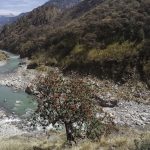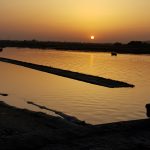Rivers of mighty Himalayas: The story beneath their echoing silence
Rivers of mighty Himalayas: The story beneath their echoing silence
Way back in 560 BC, Heraclitus felt the beauty of streams realizing the fact that we cannot step twice in the same river again as it would be the other waters and then the others that keep flowing in. Back then, no one knew that such heartily connections of humans to nature and its rivers would be more of cost-benefit relationships when we enter the 21th century. Feeling those connections embracing me from all directions, I entered the core zone of the Great Himalayan National Park, in Himachal Pradesh. Such breath-taking nature surrounded me that I was perplexed whether its actually me or is it a soul from Heraclitean times experiencing the ecstasy.
Getting to see nature with its full adornments is a divine and blessed feeling, sensate only to someone close to wilderness. The nature stood enchantingly before me, untouched by modern day human interventions. I could hear my heart thumping out loud and clear as I trekked past a risky precipice beside which River Tirthan rumbled in its full might. Such moments are just so perfectly timed when you see the sunset, hear the river roar and your heart thump against your chest, all in absolute symphony, that you remember each fraction of what your senses deliver to you.

Snorkelling all the way I could manage a peek into the fishes only up to 2000 masl.
Sampling the river all the way until the glacier for its substrate, habitat and fauna it harbours, always gives me pleasant surprises intriguing me to explore more. An organised niche, perfectly timed phenologies, a great self-healing potential and most of all, respect for each other’s space is what an untouched pristine stream like Tirthan portrays. The flora and fauna communicate in the language called ‘nature’ leaving no scope of ‘chaos’. All members live and let live! Fishes here, which are mostly trout, don’t prefer dwelling higher than a 2000 masl, but respectfully stay till an elevation which satisfies their ‘need’.
Getting down into the riverbed every few meters to snorkel and understand the hidden processes better, I was again flummoxed to find tiny macroinvertebrates all the way to the top, even under the glacier! Their body sizes increasing and colours lightening as I sampled every next sampling site a kilometre upstream. How nature has helped them adapt, is a story in its own. Snorkels gave me a peep into the beautifully intertwined food webs under the Snorkelling all the way I could manage a peek into the fishes only up to 2000 masl. stream surface. That day what I witnessed was an event beautifully timed with my underwater observational sampling. Taking control of my movements, trying my best not to scare a trout who just swam past me, I saw a carnivore dragonfly larva diligently working for its ‘meal-time’. Its movements unnoticeable, its attention all upon its prey – a stonefly larva, shredding leaf litter fallen from the riparian cover on stream beds. Prementum, a monstrous mouth part of the dragonfly larva suddenly opened up unimaginably long, reached the shredder, grabbed it and SNAP… gone! I was just so spellbound by this complete act of nature, a stream so silent has such turbulent lives of organisms dwelling in it. All along the ravines, I always spot redstarts, blue whistling thrushes, brown dippers and other riparian birds feast upon these macroinvertebrates, devouring them till a level which again, satisfies their ‘need’, leaving the latter’s population in a balanced state. Camping along the riverside on the 4th day of a 9-day long trek, it was cold due to the altitude and chilly due to the microclimate a river creates in its forested catchment.

Sampling macroinvertebrates in Tirthan just near the spot where my assistant warned me for the presence of brown bears and leopards
I was warned by the field assistant, to stay alert, “Quite a few mammals, including the brown bear and common leopard are spotted here at night, the steep gorge just ends here and the river is easily accessible to the animals to quench their thirst, so please beware!”, he said. Working in the wild since over 3 years now, such words of caution during field work are more commonplace to me. But that day, the field assistant’s forewarning drew me deeper into the impeccably interlaced natural interactions. A river has so much to give to all the animals, furthermore, it nourishes the groundwater and drenches the water tables with levels enough to sustain the riparian forest.
The inside out story moreover shows, how the forest and its animals nourish back the river with leaf-litter, faeces, minerals and nutrients. Each one derives their share of resources from the other in parity and fairness. Well, that’s what the ‘secret success story’ of undisturbed natural landscapes is, where the nature and its members follow the principle of ‘equitable access and benefit sharing’!
That night while I lay in my sleeping bag, hearing a barking deer warning call somewhere close to where we camped, the Sanskrit phrase struck me so close to heart which says ‘vasudheyva kutumbakam’, that ‘this world is nothing but a closely bound family’. Isn’t it? We need resources from this planet to sustain ourselves, but we also owe them back. The whole concept of ‘protected areas’ would not have been needed to be brought to place if we had ‘protected the planet’ as our own family since years. When organisms determine their boundaries beautifully with ranges and niches, why can’t we prevent disbalancing the whole system caused by our intrusions? Damming the rivers at certain points might be correct to fulfil our needs but damming them every few kilometres brings our ‘greed’ to the forefront. Dismally, I have recorded stunted growth in fishes as a negative response to human alterations. Organisms are trying to cope up with the havoc we humans have laid on them. It’s time we change the story back to Heraclitean times and start caring for the rivers and nature, as that is when we will start acting for them.
By: Aashna Sharma
Project Fellow,
Wildlife Institute of India, Dehradun
http://wii.gov.in/nmshe_project_fellows
aashna@wii.gov.in


